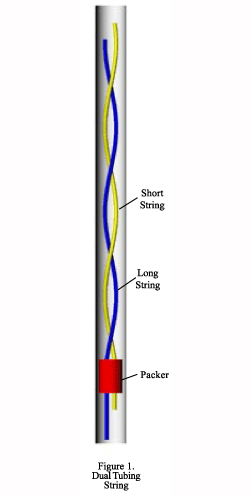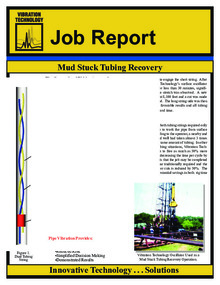MUD STUCK TUBING

The Conventional Fishing Approach
Mud Stuck tubing recovery is a commonplace activity necessary in remedial well operations. The usual approach to single string mud stuck tubing recovery is to reciprocate the tubing with a well service rig, freeing up an interval of length, then make a wireline backoff, pick up and circulate the dehydrated mud out of the hole, screw together and repeat the process as often as required in order to recover the complete tubing string.
A slightly different approach is used for dual-string wells. An initial freepoint and chemical cut is made on both strings, keeping the tubing-cut depths staggered so that only one top of fish is encountered at a given depth. After the cut pipe is laid down, a work string and overshot (with jars and drill collars) are used to engage the short string and the pipe is reciprocated with the rig in order to free additional pipe; a freepoint and chemical cut (below the cut previously made in the long string) will allow circulating the dehydrated mud out of the hole and that portion of the short string to be recovered. Now, the process is repeated on the long string and the method will eventually allow recovery of all of the well tubing.
On a recent Louisiana inland water job, Vibration Technology’s 180K surface oscillator was used by the customer to accelerate the process of recovering dual strings of 2-3/8" mud stuck tubing from inside of 7" casing. Both strings were initially cut above the packer at 13,500 feet. The short string freepoint was found to be at 4,900 feet, the appropriate upper cuts were made, tubing recovered and an overshot (without drill collars and jars) run to engage the short string. After operating Vibration Technology’s surface oscillator on the short string for less than 30 minutes, significant increase in pipe stretch was observed. A new freepoint was found at 8,100 feet and a cut was made and the pipe recovered. The long string side was then worked with similar favorable results and all tubing was recovered in record time.
A slightly different approach is used for dual-string wells. An initial freepoint and chemical cut is made on both strings, keeping the tubing-cut depths staggered so that only one top of fish is encountered at a given depth. After the cut pipe is laid down, a work string and overshot (with jars and drill collars) are used to engage the short string and the pipe is reciprocated with the rig in order to free additional pipe; a freepoint and chemical cut (below the cut previously made in the long string) will allow circulating the dehydrated mud out of the hole and that portion of the short string to be recovered. Now, the process is repeated on the long string and the method will eventually allow recovery of all of the well tubing.
On a recent Louisiana inland water job, Vibration Technology’s 180K surface oscillator was used by the customer to accelerate the process of recovering dual strings of 2-3/8" mud stuck tubing from inside of 7" casing. Both strings were initially cut above the packer at 13,500 feet. The short string freepoint was found to be at 4,900 feet, the appropriate upper cuts were made, tubing recovered and an overshot (without drill collars and jars) run to engage the short string. After operating Vibration Technology’s surface oscillator on the short string for less than 30 minutes, significant increase in pipe stretch was observed. A new freepoint was found at 8,100 feet and a cut was made and the pipe recovered. The long string side was then worked with similar favorable results and all tubing was recovered in record time.
The Bottom Line
 PDF
PDF
Total recovery of both tubing strings required only 3 cuts each and time to work the pipe from surface was minimal. According to the operator, a nearby and identically configured well had taken almost 3 times longer to recover the same amount of tubing. In other similar mud stuck tubing situations, Vibration Technology has been able to free as much as 50% more pipe per cycle while decreasing the time per cycle by 25%. The net result is that the job may be completed in one-half of the time traditionally required and the number of back offs or cuts is reduced by 50%. The obvious benefit is substantial savings in both rig time and service costs.
